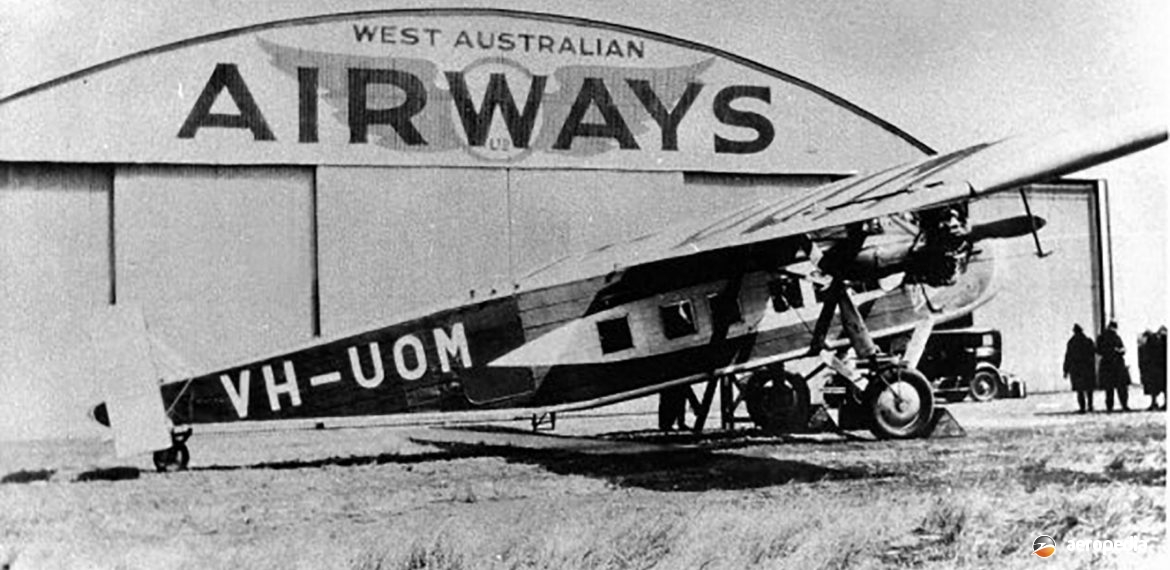Photograph:
Vickers Viastra II VH-UOM (c/n 02) at Maylands, WA 1932 (Geoff Goodall collection)
Country of origin:
United Kingdom
Description:
Commercial airliner
Power Plant:
Two 392 kw (525 hp) Bristol Jupiter XIF nine-cylinder air-cooled radial engines
Specifications:
- Wingspan: 21.33 m (70 ft)
- Length: 13.86 m (45 ft 6 in)
- Height: 4.11 m (13 ft 6 in)
- Wing area: 69.21 m² (745 sq ft)
- Max speed: 233 km/h (145 mph)
- Cruising speed: 206 km/h (128 mph)
- Initial rate of climb: 296 m/min (970 ft/min)
- Ceiling: 5,182 m (17,000 ft)
- Range: 861 km (535 miles)
- Empty weight: 3,574 kg (7,880 lb)
- Loaded weight: 4,876 kg (10,750 lb)
History:
The Viastra was designed by Vickers (Aviation) Ltd at Brooklands Aerodrome, Weybridge, Surrey, UK and was manufactured by the Supermarine Aviation Works at Woolston, Southampton. Although built in relatively small numbers, seven aircraft being completed, a variety of model numbers was used, and a variety of engines installed. The prototype Viastra I was built in 1929 and, known as the Type 160 (G-AAUB – c/n 1), was fitted with three 172 kw (230 hp) Armstrong Siddeley Lynx V engines, being able to carry ten passengers, a crew of two and 363 kg (800 lb) of baggage.
Further variants of the Viastra were designed, and a couple were completed, including the Viastra VI with one 403 kw (540 hp) Bristol Jupiter IXF engine, this model being for freight only. The last model was the Viastra X, one of which (G-ACCC – c/n 1) was built with two 485 kw (650 hp) Bristol Pegasus II.L3 radial engines with a VIP interior for the Prince of Wales, which was first flown in April 1933. It later went to the RAF as L6102 and was scrapped at Croydon, South London in 1937.
West Australian Airways was founded in August 1921 by Major Norman Brearley and over the years used a variety of aircraft, including an Avro 504J, and examples of the Bristol Tourer, DH.50, DH.66 etc. In mid-1930 the Company ordered two examples of what became known as the Type 198 Viastra II fitted with two 392 kw (525 hp) Bristol Jupiter XIF engines to supplement the DH.66 Hercules on the Perth WA to Adelaide, SA route.
The first aircraft VH-UOO (c/n 1) was flight tested at Brooklands late in 1930 and shipped to Fremantle, WA arriving on 16 February 1931. It was immediately erected at Maylands and made its inaugural flight to Adelaide on 2 March that year. This flight took 11 hours, at an average speed of 201 km/h (125 mph). A second aircraft VH-UOM (c/n 2) entered service in July that year and made news when it had to fly into a 97 km/h (60 mph) headwind, arriving in Perth only two hours late. However, VH-UOO on the return journey averaged 233 km/h (145 mph), covering the 644 km (400 miles) Kalgoorlie to Forrest section in Western Australia at 249 km/h (155 mph).
The two aircraft continued in service until VH-UOM was badly damaged in a landing accident at Redcliffe, WA on 11 October 1933. On this occasion the Viastra was climbing out of Maylands when the port engine seized and shattered the propeller, which sliced through the fuselage. The aircraft made a forced landing. The wreck was taken to Maylands and it was removed from the civil register on 31 October 1934. The aircraft was used for spares for VH-UOO until the remains were sold for scrap in June 1939. VH-UOO continued in service until the Perth to Adelaide route was sold to Australian National Airways in February 1936 and the aircraft was withdrawn from service.
In 1931 Major Brearley asked Vickers to build the Viastra with a three-engine configuration, with 336 kw (450 hp) Bristol Jupiter VIFM engines. In this form it became known as the Type 220 Viastra VIII and was able to maintain height in the event that an engine was lost. However, it seems that this was only able to be achieved at the expense of payload due to the extra weight of the third engine. West Australian Airways considered it was not an economic proposition and no order was placed for the type. One aircraft of this model was built (G-AAUB – c/n 1), which commenced life as the Type 160 at Brooklands in January 1930. It was converted to Type 199 Viastra III configuration in 1930, and Type 220 Viastra VIII form in 1931. It was dismantled at Brooklands in 1933.
One other Viastra, the VI, the Vickers Type 203, was designed as a freighter and built for West Australian Airways. This aircraft, for which the registration VH-UON was reserved, was flown from Hamble to Brooklands on 22 April 1931 using the Class B registration N-1 and was subsequently tested with the registration O-6. This was a single-engine aircraft and had a 403 kw (540 hp) Bristol Jupiter IXF engine. It was never delivered to Australia and took up British registration G-ABVM (c/n 1) when the order was cancelled. It appeared at an air-display at Brooklands on 28 March 1932 and was then dismantled.

